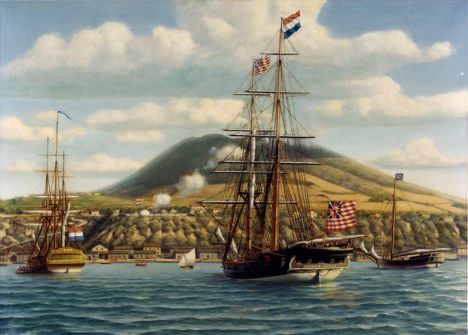On Friday, October 13, 1775, the Continental Congress in Philadelphia voted to fit out two sailing vessels to intercept transports carrying munitions and stores to the British army in America. The U.S. Navy recognizes this day as its official birthdate, although, as a Navy site history maintains, “that date in 1775 is but one of several important steps on the way to a permanent naval defense force for the American people.”
A minority in Congress, including John Adams, had been advocating establishing a Continental Navy from the outset of armed hostilities. But delegates were worried about the repercussions if the break with England were not final, and Southerners did not see a benefit to their own colonies.
But on October 5, Congress received intelligence of two English brigs, unarmed and without convoy, laden with munitions, leaving England bound for Quebec. Congress appointed a committee to consider how to take advantage of this opportunity, the members of whom were all ardent advocates of a navy. They outlined a plan for the equipping by Congress of two armed vessels to cruise to the eastward to intercept any ships bearing supplies to the British army. The proposal went nowhere until October 13, when a letter arrived from General George Washington reporting that he had taken under his command, at Continental expense, three schooners that would cruise off Massachusetts to intercept enemy supply ships. Since they already had armed vessels cruising in their name, it was seen as not such a big step to approve two more. The committee’s proposal was adopted.

The Andrew Doria was one of the brigs authorized for purchase by the Continental Congress that same month. She was originally a merchant ship named Defiance. Acquired in mid-November, she was moored in Philadelphia where she was converted into a warship by Joshua Humphreys, John Barry, and John Falconer. She was named Andrew Doria after the 15th-century Genoese admiral Andrea Doria. Under the command of Captain Nicholas Biddle, Andrew Doria departed Philadelphia on January 4, 1776, as a warship in Esek Hopkins’ small fleet of five newly-fitted warships (Alfred, Andrew Doria, Cabot, Columbus, and Providence), bound for the Chesapeake Bay. Between February 11 and 17, the fleet was joined by the small sloop Fly, the sloop Hornet, and the schooner Wasp.
The Andrea Doria is most famous for her participation in the Battle of Nassau — the first amphibious engagement by the Continental Navy and the Continental Marines — and for being the first United States vessel to receive a salute from a foreign power.

First official salute to the American flag on board the Andrea Doria in a foreign port, the Dutch fort at St. Eustatius, West Indies, 16 November 1776.
On March 27, 1794, President Washington signed into law the Naval Act of 1794, authorizing the construction of the Navy’s first six frigates. The Navy’s first ships of war were launched as follows: On 27 March 1794, Congress easily passed the “Act to provide a Naval Armament,” which promised the president six frigates, the new Navy’s first ships of war: United States (launched 1797), Constellation (1797), Constitution (1797), Congress (1799), Chesapeake (1799), and President (1800).




Leave a comment